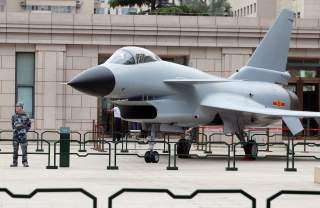Is China Getting Ready to Create Its Very Own DARPA?
Could this happen?
China has created a high-tech military research agency modeled on an American organization, state-television revealed this week.
According to the Hong Kong–based South China Morning Post, Chinese state broadcaster CCTV reported that Beijing has established the Scientific Research Steering Committee to help it develop cutting-edge military technology. CCTV also suggested that the new body will be modeled on America’s Defence Advanced Research Projects Agency (DARPA), which was set up after the Sputnik launch in 1957 to spearhead pioneering military systems to maintain America’s qualitative edge over the Soviet Union.
“As everyone knows, the internet, global positioning systems, stealth fighters, electromagnetic guns, laser weapons as well as other advanced technologies – most are DARPA-related,” CCTV reported, according to SCMP. It continued: “We should make greater efforts to promote scientific technology in our army if we want to win the competitive advantage.”
The new steering committee will report directly to the Central Military Commission, China’s highest military body, which is chaired by President Xi Jinping. President Xi has made modernizing the military a central pillar during his time in office. He is overseeing one of the largest reorganizations of the military in modern Chinese history, and constantly preaching the need to be able to “fight and win wars.” At other times, Xi has declared: “To achieve the great revival of the Chinese nation we must ensure there is unison between a prosperous country and strong military.”
To fight and win wars, China will need to acquire state-of-the-art defense capabilities. Whereas in the past it has often relied on foreign (primarily Russian) military systems, it is increasingly seeking to develop this technology indigenously. “The PLA sees technological innovation as a core aspect of military competition and seeks to draw upon Darpa’s model to achieve comparable successes,” Elsa Kania, an independent military analyst, told the Financial Times.
The CCTV broadcast said the new Steering Committee will work with the PLA’s Science and Technology Commission, which was set up last year and also reports to the Central Military Commission. A retired PLA colonel, Yue Gang, told the FT that the difference between the two groups will be that the new steering committee will focus on developing “not only the hardware but [also] the software” of China's military. Yu added that its mission would extend to helping refine military strategy and strengthening training regimens, suggesting it has a far bigger purview than DARPA.
On the other hand, a Hong Kong–based military commentator, Song Zhongping, said the new Steering Committee will “play a consultative role” in helping the Central Military Committee decide which projects to pursue at “an early stage.” Song added: “Funding, resources and the detailed implementation of these projects will be overseen by some of the 15 functional departments under the CMC.”
This is somewhat more similar to the mission of DARPA, which seeks to demonstrate the practical capabilities of new technologies and then hands it off to the military services (or civilian sector) to use as they see fit. As one DARPA pamphlet put it, “DARPA’s mission is to reveal new possibilities and enable groundbreaking capabilities by developing and demonstrating breakthrough technologies, but true success happens only when these technologies make significant, transformative improvements in the Nation’s security.”
Regardless of the exact role of the new steering committee, it is undeniable that China has overseen some significant military and other scientific breakthroughs in recent years. As I noted last week, U.S. naval officials have called China’s newer submarines “fairly amazing.” China’s first stealth aircraft, the J-20, officially went into service in March of this year.
DARPA prides itself on achieving “game-changing” breakthroughs. In this sense, one of the more DARPA-like systems China has developed is the quantum satellite that it launched into space in August 2016 but only began using for communications purposes recently.
If this system works as advertised, it will allow for “unhackable” communications between different nodes. As The Verge has explained, “The simplest application is what cryptographers call a quantum key distribution network, using the network to securely distribute long and complex encryption keys. Anyone trying to intercept those keys would be easy to detect, since it’s impossible to observe the photons in transit without altering them.”
This is not the only used of quantum technology that China has been pursuing: it has also been developing quantum radar systems. These systems are allegedly immune to jamming because they would immediately detect the interference. Furthermore, as Jeffrey Lin and P. W. Singer have noted, “Because stealth aircraft are optimized for stealth against radio waves used by conventional radars, they would be much more susceptible to detection by the photon waves of a quantum radar” (although, as Dave Majumdar has noted, there are reasons to doubt this claim).
It is these types of technologies that gave the United States an edge during the Cold War and has made it the most dominant military power in the world since the Soviet Union’s demise. If China has its way, America will no longer have a monopoly on these cutting-edge technologies. Indeed, if Beijing’s recently launched plan to become dominant in artificial intelligence is any indication, China intends to surpass the United States in many of these areas.
Zachary Keck is the former managing editor of the National Interest. You can find him on Twitter: @ZacharyKeck.
Image: A soldier stands next to a J-10 fighter jet during an exhibition for the 90th anniversary of the founding of the People's Liberation Army (PLA) outside Military Museum of the Chinese People's Revolution in Beijing, China July 28, 2017. REUTERS/Jason Lee.

